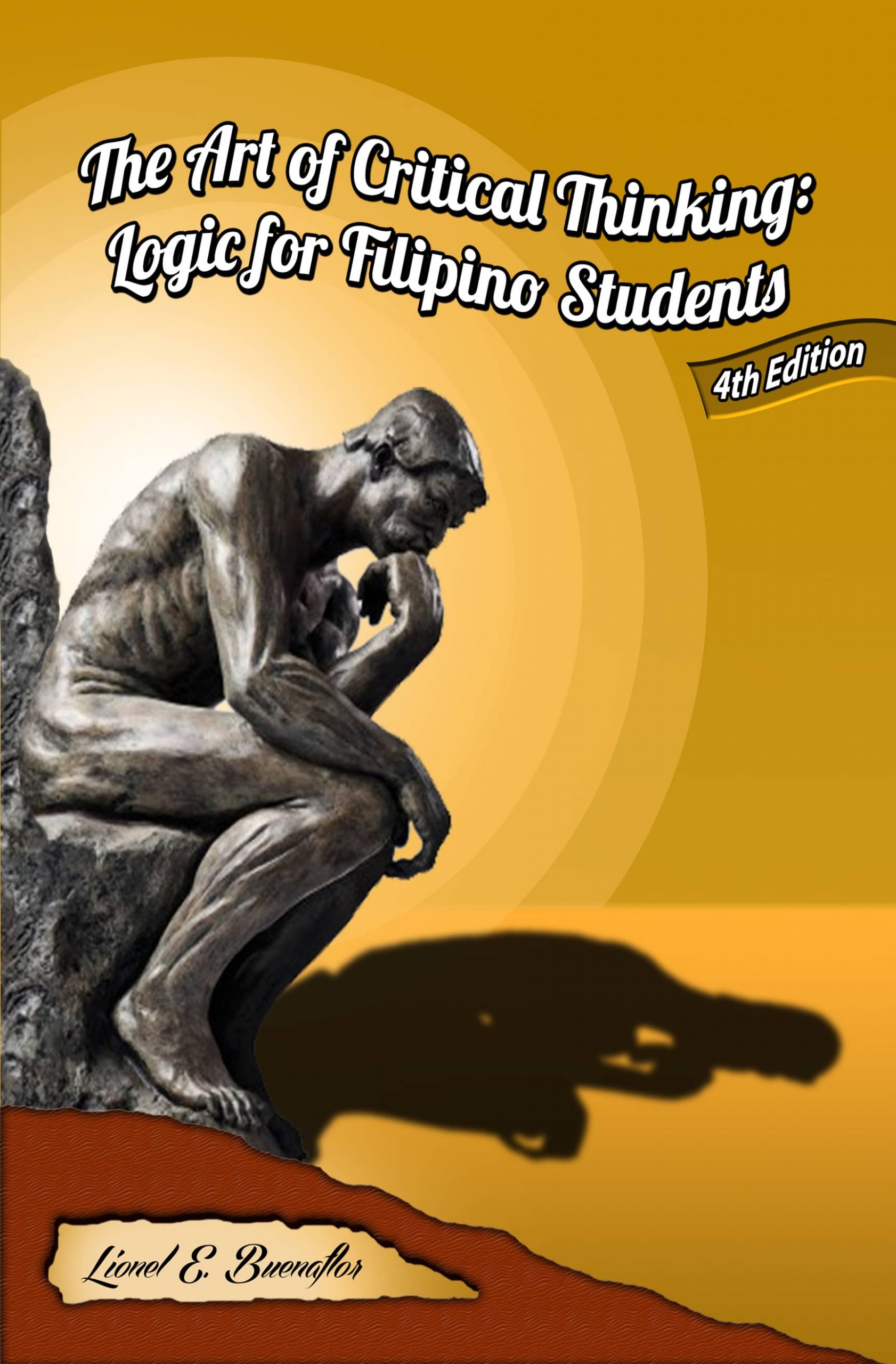The Art of Critical Thinking: Logic for Filipino Students (Fourth Edition)
₱375.00
ISBN: 978-621-409-123-2
Author: Lionel E. Buenaflor
Description
ISBN: 978-621-409-123-2
Author: Lionel E. Buenaflor
Additional information
| Book Type | Hard Copy, e-book |
|---|
Table of Contents
Table of Contents
Chapter 0: Introduction to Philosophy, 1
• The Beginning of Philosophy, 2
• The Historical Development of Philosophy, 7
• The Problem of Philosophy, 10
• The Necessity of the Study of Philosophy, 11
• The Nature of Philosophy, 13
• Philosophy, Sophistry, Pilosopo: What Philosophy is Not, 16
• The Branches of Philosophy, 19
o Philosophy of Thought, 20
o Philosophy of Reality, 21
o Philosophy of Morality, 22
• The Philosophies of Discipline, 23
• The Philosophies of Subjects, 24
• The Contemporary Philosophical Traditions, 25
• Chapter Test, 27
Chapter 1: Introduction to Logic, 33
• The Importance of the Study of Logic, 34
• Historical Development of Logic, 35
• Chapter Test, 45
Chapter 2: Problem Solving, 53
• Chapter Test, 57
Chapter 3: The Divisions of Logic, 61
• The Three Basic Functions of Language, 64
• Chapter Test, 67
Chapter 4: The Informal Fallacies, 69
• Types of Informal Fallacies, 71
o Fallacies of Relevance, 71
Argumentum ad Baculum, 72
Argumentum ad Misericordiam, 73
Argumentum ad Populum, 74
Argumentum ad Hominem, 76
Genetic Fallacy, 78
Fallacy of Accident, 78
Straw-Man Fallacy, 79
Ignoratio Elenchi, 80
Red Herring Fallacy, 81
Arithmetical Fallacy, 83
Chapter Test, 85,
o Fallacies of Weak Induction, 87
Argumentum ad Verecundiam, 87
Argumentum ad Ignorantiam, 88
Fallacy of Hasty Generalization, 89
Fallacy of False Cause, 91
Slippery Slope Fallacy, 93
Fallacy of Weak Analogy, 93
o Fallacies of Presumption, 94
Petitio Principii, 94
Fallacy of Complex Question, 97
Black or White Fallacy, 98
Fallacy of Suppressed Evidence, 99
Chapter Test, 101
o Fallacies of Ambiguity, 103
Fallacy of Equivocation, 103
Fallacy of Accent, 104
Fallacy of Amphiboly, 105
o Fallacies of Grammatical Analogy, 106
Fallacy of Composition, 106
Fallacy of Division, 107
• Detecting Informal Fallacies, 108
• Chapter Test, 109
Chapter 5: Logic of Terms, 111
• Comprehension and Extension of Terms
and Their Inverse Proportions, 113
• Kinds of Terms, 115
• Chapter Test, 123
Chapter 6: Supposition & Definition of Terms, 127
• Supposition of Terms, 127
o Classification of Supposition, 128
• Definition of Terms, 128
o Purpose of Definition, 129
o Types of Definition, 130
o Rules of a Good Definition, 134
• Chapter Test, 135
Chapter 7: Logic of Propositions, 137
• Categorical Proposition, 138
• Quantity or Extension of the Proposition, 140
• Quality of the Proposition, 140
• Quantity of the Predicate, 141
• Kinds of Categorical Propositions, 141
• Venn Diagram, 143
• Transforming a Sentence into a Logical Form, 146
• Chapter Test, 149
Chapter 8: Logical Opposition, 155
• Kinds of Inference, 155
• Kinds of Logical Oppositions and Their Truth Value, 156
• Chapter Test, 161
Chapter 9: Eduction, 163
• Types of Eduction, 163
• Chapter Test, 171
Chapter 10: Logic of Arguments, 177
• Types of Arguments, 177
o Deductive Arguments, 177
o Inductive Arguments, 178
• Categorical Syllogism, 178
• The Validity and Soundness of an Argument, 181
• Figures of Standard-Form Categorical Syllogism, 182
• The Moods of a Standard-Form Categorical Syllogism, 183
• Chapter Test, 185
• Testing the Validity of a Categorical Syllogism, 187
• Axioms of Validity of a Categorical Syllogism, 188
• Understanding the Rules of Each Particular Figure, 193
• Chapter Test, 199
• Testing the Validity of Categorical Syllogism through the Venn
Diagram Method, 203
• Chapter Test, 209
Chapter 11: Reduction, 211
• Chapter Test, 217
Chapter 12: Hypothetical Syllogism, 219
• Conditional Hypothetical Syllogism, 220
• Disjunctive Hypothetical Syllogism, 222
• Conjunctive Hypothetical Syllogism, 225
• Chapter Test, 227
Chapter 13: Special Kinds of Syllogism, 231
• Enthymeme, 231
• Epichereme, 233
• Polysyllogism, 234
• Sorites, 235
• Dilemma, 237
• Rules for Dilemma, 238
• Ways of Refuting a Dilemma, 240
• Chapter Test, 243
Chapter 14: Symbolic Notation, 249
• Using Symbols in Arguments, 250
• The Truth-Functional Connectives, 251
• Scope Indicators, 257
• Calculating the Truth Value of Compound Statements, 259
• Tautologies, Contradictions, and Contingent Statements, 261
• Logical Equivalent Statements, 263
• Sentential Arguments, 263
• Testing the Validity of Essential Arguments: Truth Tables, 264
• Chapter Test, 267
Chapter 15: The Method of Deduction, 273
• The Rules of Inference, 276
• The Rules of Replacements, 277
• Chapter Test, 281
Chapter 16: Polish Notation, 283
• Chapter Test, 289
Chapter 17: Logical and Moral Reasoning, 291
• Principles of Moral Reasoning, 292
• Moral Perspectives in Moral Reasoning, 293
• The Rule of Reason, 295
• Fallacies of Moral Reasoning, 296
• Chapter Test, 303
References, 307









